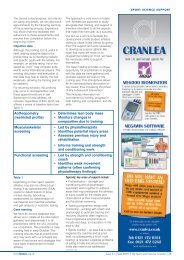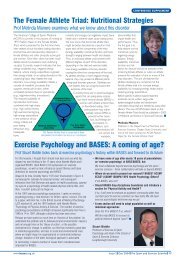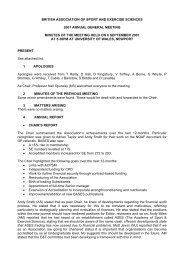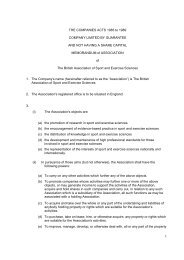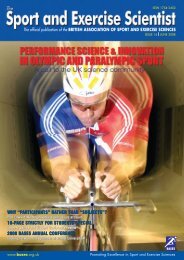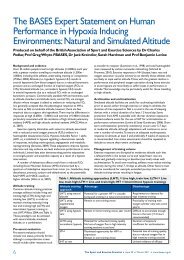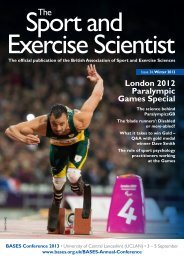Issue 31 Spring 2012 - Bases
Issue 31 Spring 2012 - Bases
Issue 31 Spring 2012 - Bases
Create successful ePaper yourself
Turn your PDF publications into a flip-book with our unique Google optimized e-Paper software.
Accidents<br />
Accidents are common in many sports, but the<br />
nature of high-risk sports means that accidents<br />
are likely to be more traumatic and potentially<br />
fatal. In terms of reducing the number of accidents<br />
occurring in such sports, an understanding of<br />
the behaviours that may predispose someone to<br />
being more accident-prone is important. We found<br />
that engaging in deliberate risky behaviours was<br />
associated with a greater number of near misses<br />
and accidents, whereas engaging in precautionary<br />
behaviours (e.g., taking time to check for potential<br />
hazards) was associated with fewer near misses<br />
and accidents. What is more interesting is that<br />
precautionary behaviours buffered the deleterious<br />
effects of deliberate risk-taking on the likelihood<br />
of accidents. In other words, danger per se does<br />
not necessarily lead to accidents; it is when danger<br />
is accompanied by a lack of precaution that danger<br />
translates into accidents. There will always be<br />
individuals who will push the limits of their sport,<br />
and that is no different in the high-risk sport<br />
domain. Clearly, some individuals will want to put<br />
themselves in situations that are so dangerous<br />
that the consequence of failing is almost certainly<br />
death. However, the results from our study<br />
show that engaging in certain behaviours (i.e.,<br />
precautionary behaviours) reduces the likelihood<br />
of such fatalities occurring.<br />
Personality<br />
While high-risk sports might not be everyone’s<br />
idea of a leisure time activity, there is evidence<br />
for the growing popularity of high-risk sports.<br />
It is therefore important to establish which<br />
individual characteristics motivate people’s<br />
engagement in high-risk sports, and to attempt<br />
to predict who may be particularly at risk in an<br />
already dangerous environment. Of the “big five”<br />
personality traits, it is neuroticism, extraversion<br />
and conscientiousness that have been central to<br />
numerous studies investigating high-risk health<br />
behaviours (e.g., Vollrath & Torgensen, 2002). In<br />
particular, conscientiousness has been a consistent<br />
predictor of an individual’s tendency to take risks<br />
in high-risk sports, with highly conscientiousness<br />
individuals taking fewer risks than individuals<br />
low in conscientiousness (e.g., Castanier, Le<br />
Scanff & Woodman, 2010). In line with previous<br />
findings (e.g., Castanier et al., 2010) we found that<br />
conscientious individuals engaged in precautionary<br />
behaviours, whereas less conscientious<br />
individuals engaged more in deliberate risky<br />
behaviours. Indeed conscientious individuals<br />
are characterised as being careful, thorough,<br />
and deliberate, therefore it is no surprise that<br />
they tend to engage in more precautionary and<br />
less risky behaviours. If we are able to identify<br />
individuals who may be more likely to engage in<br />
deliberately risky behaviours, we may be able to<br />
put measures in place to reduce the likelihood<br />
that their engagement will result in serious injury<br />
or fatality (e.g., extra safety cover, spot checks of<br />
safety equipment and competency, incorporating<br />
potential psychological antecedents of risky<br />
behaviour into sport risk management protocols).<br />
Practical implications<br />
“If human nature felt no temptation to take a<br />
chance… there might not be much investment<br />
merely as a result of cold calculation.” (John<br />
“The need for<br />
individuals to<br />
take risks is a<br />
fundamental aspect<br />
of human nature;<br />
the caveman would<br />
not have emerged<br />
from the cave to<br />
feed his family if he<br />
hadn’t taken risks. ”<br />
Further Reading<br />
Castanier, C., Le Scanff, C.<br />
& Woodman, T. (2010). Who<br />
takes risks in high risk sports: A<br />
typological approach. Research<br />
Quarterly for Exercise and Sport,<br />
81, 478-484.<br />
Horvath, P. & Zuckerman, M.<br />
(1993). Sensation seeking, risk<br />
appraisal, and risky behaviour.<br />
Personality and Individual<br />
Differences, 14, 41-52.<br />
Paquette, L., Lacourse, E. &<br />
Bergeron, J. (2009). Construction<br />
d’une échelle de prise de risques<br />
et validation auprès d’adolescents<br />
pratiquant un sport alpin de glisse.<br />
Canadian Journal of Behavioural<br />
Sciences, 41, 133-142.<br />
Vollrath, M. & Torgersen, S.<br />
(2002). Who takes health risks?<br />
A probe into eight personality<br />
types. Personality and Individual<br />
Differences, 32, 1185-1197.<br />
Woodman, T. & Bandura, C.T.<br />
(2010). The development and<br />
validation of a questionnaire to<br />
measure risk-taking behaviours in<br />
high-risk sport environments. MSc<br />
dissertation. Bangor University.<br />
Retrieved October 21, 2010, from<br />
Bangor University.<br />
Zuckerman, M. (1979). Sensation<br />
Seeking: Beyond the Optimal Level<br />
of Arousal. Hillsdale, NJ: Lawrence<br />
Erlbaum Associates.<br />
Zuckerman, M. (1983). Sensation<br />
seeking and sports. Personality and<br />
Individual Differences, 4, 285-292.<br />
Zuckerman, M. (2007). Sensation<br />
seeking and risky behavior.<br />
Washington, DC: American<br />
Psychological Association.<br />
Maynard Keynes)<br />
The concept of risk lies at the very centre<br />
of economic expansion; it is the driving force<br />
behind discoveries and scientific development. The<br />
need for individuals to take risks is a fundamental<br />
aspect of human nature; the caveman would not<br />
have emerged from the cave to feed his family if<br />
he hadn’t taken risks. Thus, when proposing any<br />
preventative or safety strategies for high-risk<br />
sport participation it is important to recognise<br />
and maintain the element of risk that many<br />
participants specifically strive for.<br />
With freestyle skiing and snowboarding<br />
enjoying its place in the Winter Olympics and<br />
current proposals by the International Sailing<br />
Federation for the inclusion of kitesurfing in<br />
the 2016 Olympic Games, the popularity of<br />
high-risk sports is on the rise. This amplifying<br />
interest in high-risk sports calls for appropriate<br />
safety measures and accident prevention<br />
strategies. Regulators of sports such as freestyle<br />
skiing – making its debut in the 2014 Winter<br />
Olympics – recognise the dangerous nature<br />
of these sports and have focused on physical<br />
safety and accident prevention measures such<br />
as mandatory helmet use and air bags on the<br />
sides of pipes during practice. However, it is clear<br />
that sports regulators may need to consider the<br />
psychological antecedents of risky behaviour in<br />
adventure sports (e.g., low conscientiousness) in<br />
order to ensure appropriate safety and accident<br />
prevention measures are in place. Consequently<br />
the RTSI could be used to identify an individual’s<br />
tendency to take deliberate risks in sport that<br />
could be beneficial in creating sport-specific<br />
injury prevention strategies and in developing<br />
safety guidelines for use in personal, coaching<br />
and training environments, and in businesses that<br />
provide recreational high-risk sport services.<br />
Take-home message<br />
Although research into the differing behaviours<br />
of high-risk sport participants is in its relative<br />
infancy, there is evidence to suggest that high-risk<br />
sport participants are certainly not all deliberate<br />
risk-takers. In fact, it is likely that one of the<br />
main attractions for high-risk sportspeople is the<br />
management and control of risk rather than risk<br />
per se. For many years much of the research has<br />
been based upon sensation seeking, and therefore<br />
researchers have overlooked the prospect that<br />
some high-risk sport participants deliberately<br />
engage in risk-taking activities, others adopt safe<br />
options within the high-risk sport domain. These<br />
recent findings change the way people view highrisk<br />
sport participants, and creates an exciting<br />
avenue for future research in the domain.<br />
words: Dominika Kupciw<br />
Dominika Kupciw is an MSc Applied Sport and Exercise<br />
Psychology graduate at Bangor University, qualified kitesurfing<br />
instructor and extreme sports enthusiast.<br />
Alexandra MacGregor<br />
Alexandra MacGregor is an MSc Applied Sport and Exercise<br />
Psychology graduate at Bangor University. She is currently studying<br />
for a PhD at Bangor University in the area of adventure sports.<br />
Acknowledgements<br />
The authors would like to thank Dr Tim Woodman, School of<br />
Sport, Health and Exercise Sciences, Bangor University, for his<br />
assistance in writing this article and his valuable guidance in<br />
conducting the abovementioned research project, and to all<br />
participants who took part in the study.<br />
The Sport and Exercise Scientist n <strong>Issue</strong> <strong>31</strong> n <strong>Spring</strong> <strong>2012</strong> n www.bases.org.uk<br />
29



